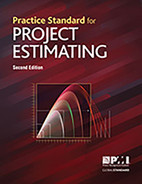APPENDIX X1
THE PRACTICE STANDARD FOR PROJECT ESTIMATING—SECOND EDITION CHANGES
This appendix provides a high-level overview of the changes made to the Practice Standard for Project Estimating – Second Edition to assist the reader in understanding the changes from the previous edition to the current edition.
The Practice Standard for Project Estimating – Second Edition brings in current concepts used throughout the world in estimating portfolios, programs, projects, as well as operational activities. While many of the estimating techniques in use to today reflect what has been long proven in the workplace, some practices have fallen away and newer practices and techniques have added depth to project life cycle estimation. Adaptive life cycles, sometimes referred to as agile or Iterative, have become mainstream and hybrid life cycle applications more prevalent. This practice standard integrates new techniques, such as relative estimation, and eliminates less common practices, such as power estimating techniques.
In addition, this practice standard increased the use of examples and case studies to demonstrate and contrast the different techniques to increase experiential learning. In response to this need, this practice standard includes a fictional case study on a custom bicycle project to reflect the reality of mixed life cycles and project complexity occurring more often than not in our business world. In addition to the bicycle case study, examples of projects around the world encountering significant challenges in estimation are provided for discussion and to underscore the critical value that estimation practices bring to project environments.
Significant emphasis is placed on the use of lightweight adaptive estimation to educate both seasoned project managers in these new practices and less experienced project team members. The intent is not to provide an exhaustive list of practices and their variants. Rather, it is to illustrate the fundamental elements of the different types to allow the user of the practice standard to better select a practice that might more efficiently address the specific project environment and culture being faced. Another change is the increased emphasis on the need for individuals doing the work to estimate their own work and the recognition that estimation must be a continuous activity to fine tune and adapt to lessons learned and emergent situations.
Finally, the Glossary is updated to reflect the terms used in today's project world as well as a quick resource when using the practice standard.
